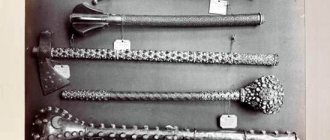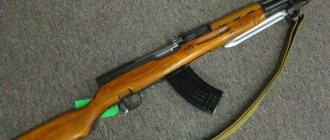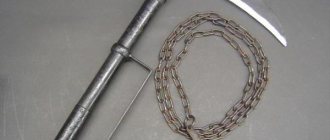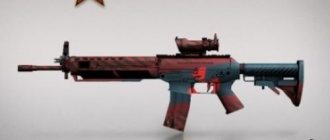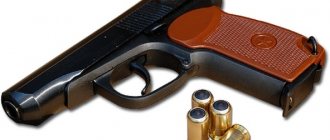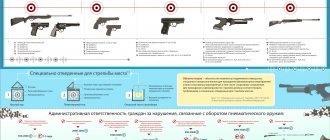Battle Flail
,
threshed
,
combat scourge
[1] - a contact bladed weapon with impact and shock-crushing action, consisting of two (less often - three) flexibly articulated hard sticks. Most varieties of these weapons come from the agricultural flail.
Flail segments - handle ( flail
,
held
) and impact weight (
beat
) - were usually wooden and connected using a short suspension - a rope or a small-link chain.
Flails in history
The real history of the use of flails confirms these theoretical calculations. The flail is popular among the Cossacks, Haidamaks, robbers - in other words, light cavalrymen and raiders. The Knight also carries similar things with him, but does not rely on them as his main weapon.
A two-handed flail becomes a trump card in the hands of the Hussites, Flemings, and participants in peasant riots - when untrained infantry suddenly turns out to be a more than adequate counterweight to the knightly elite. This is not the same as what happened, say, under Crecy: the English longbow is a highly professional weapon, you cannot equip yesterday’s farmers with it. Only a gun could give a similar effect; and it is no coincidence that those same Hussites became the first to massively use guns in the war. However, this is a completely different story.
| Flagellants in Warhammer: Mark of Chaos are armed with a strange hybrid of two-handed and one-handed flails: the handle and chain are like a battle flail, the weight is like a two-handed one, and nails are driven into it. |
Peasant rebels have always loved flails also because wearing them is in no way incriminatory. The peasant threshing machine will definitely not fall under the edicts banning weapons; Should they somehow collect and process the crop? This is where all sorts of eastern fighting techniques grow, “in that they are definitely not weapons.” By the way, this is also relevant these days.
In regular infantry, weapons of this type are unpopular because they do not allow them to use an important advantage - discipline, drill training (now this is a rudiment, a way to train the obedience reflex, and in the Middle Ages it was the basis of survival and the key superiority of experienced infantry over the militia).
The chronology of the use of flails is not very interesting to write. They had neither periods of dominance on the battlefield nor declines, like, say, bows; there was something like a golden age at the end of the Middle Ages (aka the decline of knightly cavalry), but even there the peasant’s flail was opposed by a professional halberd (and its relatives - the godendag, the Lucerne hammer and others).
The design also did not change much, although the bone apple was gradually replaced by bronze, iron, and then steel, and spikes appeared and disappeared. The flail is not a very technologically advanced weapon; there are few tricks in its manufacture.
The history of this weapon is not over even today. The flail successfully survived the sword, ax, and ax; it is easy to hide, and that is why they are still used today
used during all sorts of riots and revolutions, it is used by bandits, and in some places by law enforcement forces (although this is not advertised). True, modern flails often use a spring instead of a chain - it is foldable, and when you press a button, the weight on the spring flies out of the handle.
Let's now try to understand the types of flail. It would seem that what can you come up with here? But in fact, there are many varieties of this weapon...
Asia
In China, Japan and Korea, combat flails were much more diverse, and the technique of using them was more complex. The Chinese weapon Shaozigun was similar in design to European flails. However, flails were more common, in which all the sticks simultaneously function as both the warhead and the handle. The most famous are the Japanese weapons Nuntyaku - consisting of two equal-sized sticks, and the Chinese weapon Erzegun, which is close to it. In China, the liangzegun flail was used, consisting of two sticks, each of which was about a meter long. There were also three-section modifications - san-setsu-kon and sanjiegun. There was even a four-section flail - yon-setsu-kon, the inner rods of which were one and a half to two times shorter than the outer ones. The technique of using such weapons includes not only striking, but also various rotations and interceptions.[7]
In China and Korea, combat flails were used not only by infantry, but also by cavalry, and in Korea in the 16th-17th centuries they were widely used in this capacity. This was due to their low cost, relative ease of use and impact power. The length of the Korean cavalry flails was 40-50 cm and was bound with iron. When working with them, it was possible to use both a two-handed and one-handed grip.[8] In addition, the shalk-ethme's
were common in the Kazakh and Kyrgyz cavalry in the Late Middle Ages and Modern Times[9].
- Mayal de armas chino.jpg
Korean cavalryman with a combat flail, XVI-XVII centuries.
- Chinese flail 1.jpg
Battle flail, illustration from the Chinese treatise Ubei Zhi, 17th century.
- Chinese flail 2.jpg
Chinese three-section flail from the Ubei Zhi treatise, 17th century.
- Nunchaku 1.JPG
Nunchakus.
- 3-sectional-staff.jpg
Modern three-section flail.
Flail
The flail differs from other flails in its high mobility and compactness of the load. It has a fairly long suspension (at least 25 cm, usually up to half a meter), which allows you to spin the weight at a speed of approximately one revolution per second.
The handle, on the contrary, is short - no more than 30-35 cm. There are brushes with a handle of 15 centimeters (it almost completely fits in the hand) and even without a handle at all - strap-on ones, in which a belt or chain is attached directly to the hand.
Attention - a myth: the flail is a purely equestrian weapon and comes from a whip.
Among the nomads this was certainly the case; but the peoples of Western Europe have excellently traced the lineage of the flail from the peasant flail. In the end, the weapon turned out to be the same... Well, its “fundamental unsuitability for infantry” is refuted by the fact that flails served the bandits very well right within the city (what horses there are!), and to this day they turn out to be a serious alternative to brass knuckles.
There were spiked flails, but more often there were simply protrusions on the ball, rather than sharp “rays”.
The flail is probably the most popular of the military flails; in any case, it was used for many centuries and in a variety of countries. But he was almost never the only one
fighter's weapon: the reasons are stated above.
Pillars of Eternity Weapon - Flails
Flails are known among soldiers for their ability to penetrate shields.
Battle Flail
Flail
Lead: 30 (Weakness) Damage: 8-12 Blunt vs. Deflection Converting a light hit into a normal one: +10% - radius at which a light hit deals normal damage Cost: 5 cp Flails consist of a metal ball, often spiked, attached by a short chain to a wooden or metal handle. They are known among soldiers for their ability to penetrate shields.
Choir battle flail. quality
Fine Flail
Lead: 30 (Weakness) Damage: 8-12 Blunt vs. Deflection Converting a light hit into a normal one: +10% - radius at which a light hit deals normal damage Quality: +4 Accuracy, x1.15 All Damage Cost: 205 cp
Combat flail ex. quality
Exceptional Flail
Lead: 30 (Weakness) Damage: 8-12 Blunt vs. Deflection Converting a light hit into a normal one: +10% - radius at which a light hit deals normal damage Exceptional Features: +8 Accuracy, x1.3 All Damage Cost: 405 cp
"Ghaun's Share"
Gaun's Share
Lead: 30 (Weakness) Damage: 8-12 Blunt vs. Deflection Converting a light hit into a normal one: +10% - radius at which a light hit deals normal damage Quality: +4 Accuracy, x1.15 All Damage Slashing Lash: +25% Slash Damage Cost: 405 cp
A lesser known aspect of the god Eothas, Ghaun represents the cyclical nature of life and the seasons and is often depicted as a farmer with a scythe. He is more popular among Eothas's rural followers, who are drawn to his various guises as provider, shepherd of the dead, and defender of justice.
The Share of Ghaun is said to have been made by a grief-stricken Dyrwood blacksmith after his home was destroyed in a Glanfathan raid. Arriving at a neighboring village, the blacksmith immediately began working to create a weapon that could be used to avenge the harm caused to the village. After several weeks of hard work, he had a heavy flail covered with small blades in the shape of a scythe, with which he intended to send the returning invaders to the next world.
"The Unforgiven"
Unforgiven
Lead: 30 (Weakness) Damage: 8-12 Blunt vs. Deflection Converting a light hit into a normal one: +10% - radius at which a light hit deals normal damage Exceptional Features: +8 Accuracy, x1.3 All Damage Speed: x1.2 Attack Speed Fire Lash: +25% Fire Damage Cost: 905 cp
The origin of this item is a matter of debate between the followers of Eothas and Voedika. Supporters of Eothas believe that their priests commissioned it shortly after the end of the Holy War, in the hope that it could persuade their god to return and finish what he started. Meanwhile, Woedica's supporters say the item is older, and was used to punish oathbreakers who originally worked for the Steel Garrote, an order of Woedica paladins dedicated to enforcing oaths and contracts, often in merciless ways.
The flail itself is unique in that the spiked ball at the end is made from an incense burner, and when actively used, the smell of incense spreads around. The reputation of this weapon was so great that in a number of cases, when someone refused to fulfill their promise, they were intimidated by the smell of incense appearing in the meeting room or bedroom.
"Star Caller"
Starcaller Lead: 30 (Weakness) Damage: 8-12 Blunt vs. Deflection Converting a light hit into a normal one: +10% - radius at which a light hit deals normal damage Exceptional Features: +8 Accuracy, x1.3 All Damage Speed: x1.2 Attack Speed Fire Lash: +25% Fire Damage Cost: 905 cp
Extinguished
The design of the extinguisher differs little from the hanging flail; but his belt ends in an easy-to-grip loop that allows him to be thrown
. Thus, the extinguisher combines the features of an obtrusive flail and... a bola (we talked about it in the article on slings). True, the main effect of the suppression was still impactful, not confusing.
There were extinguishers with a suspension of several meters; These could be used as a regular sling (if you wrap the pendant around your hand), or they could be thrown around - and then pulled back out like a harpoon. However, the use of such weapons requires very unusual conditions.
The closest modern relative of the extinguisher is the sports throwing hammer; they are structured almost identically. True, the hammer is perhaps heavier: 7 kg. By the way, the range record (Yuri Sedykh, 1986) is 86 meters
; evaluate the range of the weapon...
A robber's stun projectile is sometimes called extinguisher - a bag of sand or shot on a short rope (in English - sap).
Scourge
The whip can also be a common means of giving the horse additional acceleration; a fighting whip is usually distinguished by its large weight and a weight (weights) at the end. It is also called the battle scourge
or
a combat Kamcha
(and sometimes confused with a flail).
A shortened whip is also called a whip
(
nogaika
).
The weights on it are much smaller and lighter than those of the flail, which is why they can be used a lot. Almost always it is a weapon of light cavalry (although there were exceptions). The Cossacks and steppe people lived happily until the twentieth century.
Kusari-gama
Kusari-gama.
There are many strange things among eastern weapons, but the kusari-gama stands out even among this series. It consists of three parts: a sickle-kama, a chain is attached to it by the handle, and at the other end there is a steel apple.
Many other eastern flails are peasant, secret weapons, but not the kusari-gama: although it is made of a sickle-kama, it is impossible to pass it off as a peaceful instrument. There is a whole martial art called kusari-gama, and, according to some sources, it was a wonderful counterbalance to the most popular types of samurai weapons - the sword and the yari spear. There is a legend about the famous master Kusari-gama, who defeated many swordsmen until one of them lured him into a bamboo grove; among the dense growth, as already mentioned, you can’t wave a flail.
However, Eastern wisdom is a topic for a separate article (and more than one), and probably not mine: on the shaky soil of the shores of the Yellow Sea, I don’t feel too confident.
Moneybox of knowledge
Impact weapon with flexible coupling
For impact weapons using a flexible coupling, terms such as “flail”, “battle scourge” and “battle flail” are used, and for a variety of eastern samples even “battle chain”. To avoid confusion in the future, we will call a flail a striking weapon consisting of a handle and a striking part, connected to each other by a flexible coupling, and intended for combat with one hand. We will call combat flails large specimens that originate from peasant flails for threshing grain and are intended for two-handed combat.
Impact weapon with flexible coupling
70. Double flail, India, XIX century. 71. Flail with a short coupling, Germany, 16th century. 72. Triple flail, Germany, XV century. 73. Flail with flexible leather part, Russia, 18th century. 74. Flail on a steel handle, India, XIX century. 75. “Kettlemorgenstern” - “morning star” flail, Germany, 16th century.
The flail as a weapon most likely originated from the whip - a whip used to urge a horse. The classic flail is a weight connected by a rawhide chain or strap to a wooden handle. The weight was usually made of iron or bronze, and the inside of the weight was often filled with lead. Bone weights with a metal rod inside were also used. The weight of an ordinary flail weight rarely exceeded 200-250 g. The length of the handle could vary significantly, but on average it was 40-50 cm. There were options without a handle at all - just a weight on a belt. The wide distribution of the flail was recorded among the nomadic Khazar people already at the beginning of the 8th century. Thus, the flail was originally a horseman's weapon. The purpose of the flail was the same as that of the rest of the striking weapons - to stun and stun an enemy protected by armor. However, despite the similarity of tasks, the flail had a number of features associated with its original design. In the early Middle Ages, a flail was a relatively expensive weapon. The presence of a metal chain and attachment to the handle made its production more labor-intensive, and the cost higher, compared to a regular mace. The disadvantages of the flail include the difficulty in controlling the weapon and the danger of accidentally striking both one’s comrade and the owner himself. It is also necessary to take into account the comparatively lower reliability of the flail design, compared to the same mace. In addition, the flail was completely unsuitable for repelling enemy attacks and therefore, as a rule, was used in conjunction with a shield. The main advantage of the flail is the ability to bend around the enemy’s defense thanks to its flexible part and deliver unexpected blows. Gradually, with the development of blacksmithing, the flail became available to foot soldiers. Similar to a simple mace, the poorest warriors, the militia, began to use the flail on foot.
Triple battle flail,
76. Peasant flail for threshing grain, reinforced with metal strips, Western Europe, 16th century. 77. Triple battle flail, Western Europe, 16th century. 78. Battle chain - a metal weapon of eleven links, China, 19th century.
The flail was widely popular among the civilian population, largely due to the possibility of concealed carrying - as a weapon of self-defense and attack. In Russia, the very word “kisten” is associated primarily with robbers. The battle flail is a modernized version of the peasant flail for threshing grain, a weapon that was often used by peasants in many different parts of the globe. If in Europe it was usually a large flail for fighting with two hands on foot (Fig. 76, 77), then in Southeast Asia it was transformed into numerous variants of a multi-link flail. The most famous representative of such “civilian” weapons can be considered the famous nuntyaku. All kinds of sectional weapons were also widespread in China and Japan (Fig. 78). However, despite all their diversity and popularity, such models could not compete with the weapons of a professional warrior - a spear and a sword, as a rule, remaining an auxiliary means of self-defense for the civilian population.
Russian warrior, XIV century.
Russian warrior, XIV century. The army of the Russian principalities in the X-XV centuries. consisted of a squad - professional warriors in the service of the prince, who fought mainly on horseback, and an infantry militia, which was convened from peasants and artisans in case of war. Large principalities maintained squads of 2-3 thousand soldiers, small ones were content with several hundred. The squad received land plots for their service. The warriors could be both Slavs and hired soldiers - Varangians, Polovtsians, Byzantines. In 1237, Mongol conquerors came to Rus' under the leadership of Genghis Khan’s grandson, Batu. The fragmented Russian principalities were unable to repel the invaders. The consequences of the Mongol invasion for Rus' were the most catastrophic. Many cities were burned, people were driven into slavery. Rus' was forced to pay tribute to the invaders for almost three centuries. In 1380, the Moscow prince Dmitry, later nicknamed Donskoy, managed to unite the forces of several Russian principalities and deal a decisive blow to the Golden Horde, weakened by internal strife - the state founded by Batu Khan and separated from the Mongol Empire. In the Battle of Kulikovo, the enemy led by Khan Mamai was defeated. But for almost 100 years after this, the Russian principalities paid tribute to the Horde. However, it was from this moment that the revival of the Russian state and the identification of Moscow as the central city of the state began. It is generally accepted that the weapons and armor of the ancient Russian warrior were a cross between the “heavy” Western models and the “light” Eastern ones. In practice, the set of defensive and offensive weapons of the Russian warrior in the X-XIV centuries. could vary greatly depending on the region of use and the potential enemy. For example, in the Kiev and other southern principalities the influence of the steppe set of weapons was extremely great. In the Pskov and Novgorod principalities, European influence was felt more strongly. Steppe defensive weapons in the 10th-13th centuries, contrary to widespread belief, were often heavier than European ones. In general, the general complex of weapons of the Russian warrior of the 14th century. was closer to its eastern counterparts. Protective weapons of a warrior in the 14th century. consisted of a helmet, plate or scaly armor, under which chain mail was sometimes put, an almond-shaped or triangular shield. The set of protective equipment could also include bracers and leggings, which were widespread among the Mongols. The offensive weapons of the Russian warrior consisted of a bow, darts, a spear and auxiliary striking weapons - a hatchet, mace or flail. Since the 12th century. The saber, being more convenient for mounted combat, is gradually replacing the sword from the set of weapons of the Russian warrior, especially in the southern regions.
Peasant, Western Europe, XV century.
Peasant, Western Europe, XV century. The history of Europe is not only the history of the wars that the rulers of states waged among themselves. This is also an endless series of peasant unrest and riots. During the early Middle Ages, the free tiller gradually turned into a serf, a worker completely subordinate to the feudal lord. The position of a serf was not much better than that of a slave. He was forced to give most of the harvest to the lord, in return for which he received his patronage and military protection. Another part of the harvest was supposed to be given to the church; besides this, there were many other duties. As a result, the standard of living of the peasants, despite the hard and exhausting work, was extremely low. For this reason, peasant uprisings broke out regularly in Europe. The rebels, as a rule, brutally dealt with their masters and their associates and went into the forests, turning into ordinary robbers. But sometimes local unrest grew into mass discontent. In such cases, huge armies of rebellious peasants posed a real threat to royal power. Usually the rebels were extremely poorly armed and organized. Agricultural implements converted for combat were used as weapons - scythes, flails. Often the weapons were homemade - homemade spears, mortars, clubs, knives. Peasants, as a rule, did not have protective weapons. The peasants did not have combat skills or competent tactical organization. Therefore, battles with professional warriors - royal troops or squads of feudal lords - usually ended in a crushing defeat of the rebels, followed by brutal reprisals against the vanquished. In a number of cases, the rebel armies managed to win a number of major victories. The Hussite uprising in the Czech Republic in the first half of the 15th century is widely known. Led by a professional military man, Jan Zizka, the rebels were able to put up stubborn resistance and inflict a number of defeats on the troops of the German Holy Roman Empire, but as a result they were still defeated. The rebels - they were also called taborites, due to the widespread use of tabors - carts - used original tactics to fight the knightly cavalry. Using their carts, set up in a circle as a fortified camp, the Taborites shot the knights from cover with firearms and crossbows. The combat flail was very popular among the Taborites, which turned out to be an unexpectedly effective weapon against knights clad in armor. As a result of the Hussite people's liberation movement, the Czech Republic finally gained independence.
Read about this topic on the website:
Edged weapons Bayonets Throwing weapons of original design Masked and combined weapons Combination weapons Folding and throwing knives Spike knives Machetes Short-bladed weapons of Southeast Asia
Battle Flail
| Kettenmorgenstern. True, the lanyard is usually a belt one, not a chain one - it’s inconvenient and unpleasant. |
We looked at what would happen if we shortened the handle of the brush, and now we’ll try to lengthen it. It turns out to be a battle flail; it's almost a brush, but heavier. Handle up to half a meter, load 500-1000 g.
A combat flail is better suited for an infantryman, although it can also be used by a horseman. It penetrates armor well (this is where a spiked ball is appropriate: such a weapon is called a Kettenmorgenstern
), but hits slower than a flail. Professionals are armed with it, and not as their only weapon.
Two-handed flail.
Notes
- ↑
Battle scourge // Encyclopedic Dictionary of Brockhaus and Efron: in 86 volumes (82 volumes and 4 additional). - St. Petersburg, 1890-1907. - ↑
Stephen Turnbull: The Hussite Wars 1419-36, Osprey MAA 409, 2004 - ↑
Douglas Miller: Armies of the German Peasant's War 1524-26, Osprey MAA 384, 2003 - ↑
P. A. Dyakonov “Flexible-joint objects of impact-crushing action” - ↑
See illustration. - ↑
Mair, Paul Hector: De arte athletica I - BSB Cod.icon. 393 - ↑
K. V. Asmolov. History of edged weapons. Part 2. M., 1994. - ↑
K. V. Asmolov. Imjin War 1592-98 and a Korean warrior of the 16th - 17th centuries. - ↑
Bobrov L.A. Iron hawks of Maveranahr (a complex of defensive weapons for warriors of Central Asia and adjacent territories of the late 15th - 17th centuries) // Para bellum. - St. Petersburg, 2003. - No. 18.
Two-handed flail
Two-handed flail (aka threshing
) directly comes from peasant; most often this is an agricultural tool, at most with a weight weighted or studded with nails.
Its handle is one and a half to two meters long, and the suspension is very short, literally a few links. It is not intended for serious military equipment; the ears usually do not dodge. And in battle, all hope is that you will have time to strike first, because a fighter with a two-handed flail is absolutely unprotected. There is nothing to hold the shield with, and you won’t be able to parry either. In short, this is truly a suicide weapon; however, it served the Hussites and Flemings faithfully due to their numerical advantage and the fact that the knights stubbornly continued to underestimate “these men with flails.”
There were two-handed flails with several loads, but in battle the extra ones were usually unhooked - very inconvenient; one such flail became a scepter in ancient Egypt.
Asia[edit | edit code]
In China, Japan and Korea, combat flails were much more diverse, and the technique of using them was more complex. The Chinese weapon Shaozigun was similar in design to European flails. However, flails were more common, in which all the sticks simultaneously function as both the warhead and the handle. The most famous are the Japanese weapons Nuntyaku - consisting of two equal-sized sticks, and the Chinese weapon Erzegun, which is close to it. In China, the liangzegun flail was used, consisting of two sticks, each of which was about a meter long. There were also three-section modifications - san-setsu-kon and sanjiegun. There was even a four-section flail - yon-setsu-kon, the inner rods of which were one and a half to two times shorter than the outer ones. The technique of using such weapons includes not only striking, but also various rotations and interceptions.[7]
In China and Korea, combat flails were used not only by infantry, but also by cavalry, and in Korea in the 16th-17th centuries they were widely used in this capacity. This was due to their low cost, relative ease of use and impact power. The length of the Korean cavalry flails was 40-50 cm and was bound with iron. When working with them, it was possible to use both a two-handed and one-handed grip.[8] In addition, the shalk-ethme's
were common in the Kazakh and Kyrgyz cavalry in the Late Middle Ages and Modern Times[9].
- Korean cavalryman with a combat flail, XVI-XVII centuries.
- Battle flail, illustration from the Chinese treatise Ubei Zhi, 17th century.
- Chinese three-section flail from the Ubei Zhi treatise, 17th century.
- Nunchakus.
- Modern three-section flail.
Double-headed flail
| Double-headed flail with one-sided fastening. |
And here is the double-headed flail, so beloved by game makers - and so unpopular in real life. Moreover, oddly enough, these chains were usually attached not to one side of the handle, but to different sides (therefore, of all the types of double weapons in D&D, only the dire flail - this very double-headed flail - and the staff are related to reality). Possession of such a flail requires very subtle technique, perhaps more cunning than with kusari-gama.
Variants with two or three heads on one side of the handle were found... occasionally
. We cannot say with certainty that they were ever used in combat. It is possible that they are the same ceremonial weapons as the two-handed sabers that were at one time used by the palace guards in several Central Asian cities.
Kettlebell 4 pounds (64 kg.)
The joy of the spirit is a sign of its strength.
(Ralph Emerson)
How to make a kettlebell weighing 4 pounds (64 kg) yourself? For example, I have never seen a weight weighing 4 pounds (64 kg) - not just for sale, but just like that. Although it turns out you can buy it now - at a price of 8,700 rubles. But a little earlier, in 2020, it seemed that they could not yet be found on sale, and so a man got started and made weights of 4 pounds (64 kg) - on his own. (In fact, judging by the scales, the weight turned out to be 60 kg, although the author wrote 4P on it - 4 pounds, and each pood, as you know, is a little more than 16 kg. But it doesn’t matter - apparently there were some reasons to make it exactly 60 kg. In any case it was possible to add another 4 kg.
So, how to make your own kettlebell weighing 4 pounds (64 kg) - In another article from the site “Fizkult-hello” (link to the site at the end of the article). A short story about how the author of the site almost accidentally found people who cast weights in Russia. And in the end I received two full 64 kilogram weights. (Actually hollow - and then he poured the required amount of lead into them himself, and added a bolt to make it possible to increase the weight.)
Kettlebells 60 kg.
Hello everyone!
After purchasing and modifying the ZESO weights weighing 50 kg, I didn’t even really dream of weights of a larger weight. Because they simply aren’t sold in Russia, or at least I haven’t seen them, except for Eleiko 56 kg, which cost 13,000 rubles apiece. They do not have a very pleasant appearance due to the thick and awkwardly shaped handle. Simply put, the design of the entire kettlebell from Eleiko is very poorly thought out. How can the bourgeoisie understand our unique Russian projectile? And ordering from abroad is a little better in design, but still not very good, for example on a German website, it will cost a pretty penny. Delivery of two 60 kg weights to Russia will cost at least 500 euros. So this option is also not suitable, especially against the backdrop of rising foreign currencies. What remains is casting to order, but no matter how many times I found foundries in my Chelyabinsk, everyone raised their prices and offered a minimum batch of 50-100 pieces. It’s understandable that anyone wants to tinker with small orders; after all, they want to make money big and as simply as possible.
In general, I had almost no hope of getting hold of a kettlebell weighing more than 50 kg. But as they say: “thoughts materialize” and “he who seeks will always find.” One fine morning, an acquaintance sent me a VKontakte link to the BruttoBells group. The guys started doing foundry work, and also for fun, so to speak, they cast weights of any shape and weight to order.
Initially I wanted to cast solid weights, but later I found out that Alexander Krolevsky was also going to cast weights from these guys. But he was going to order hollow weights filled with lead, this would make the weight cheaper and give you the opportunity to choose what weight you needed: 56, 60 or 64 kg. It will also significantly reduce the size of the weight, which will make it more convenient. After some thought and calculations, I decided to cooperate with Alexander. What followed was a long discussion about the size of the weight, but a middle ground was found. This concept was born:
Kettlebell parameters:
- Total height 310 mm
- Core diameter 233 mm
- Prosov 60 mm (distance from the handle to the body of the weight)
- Handle diameter 37 mm
- Empty weight 18.3 kg
Next, after approval of the size and shape of the weight, work followed on the manufacture of equipment for casting. Which was taken on by the guys from BruttoBells.
As you can see, Alexander Krolevsky wanted to make a personalized weight, as its author. For BruttoBells, this is a no-brainer. I preferred to limit myself to the simple inscription 4P.
After making the equipment, of course, there was the last phase - casting the weights. In the end, this is what happened:
Well, that’s all, the weights were ready, then I had to visit the glorious city of Yekaterinburg to pick up my two weights. Fortunately, it’s not that far to travel from Chelyabinsk to Yekaterinburg, only 200 km. It was possible, of course, to use the services of a transport company, but I wasn’t averse to taking a ride and meeting the guys from BruttoBells personally.
Upon arrival home, I took several photographs in comparison with the best representatives of the Soviet era, KZ and KLZ weights, as well as with the recently acquired and modified 50 kg ZESO:
As you can see, the quality of the casting is excellent, and the shape of the core of the 4P is an honest ball, while the ZESO still has something similar to an ellipsoidal ball. Also, the handle of the ZESO is slightly flattened to the touch, while the handle of the 4P is of a regular round shape.
Now I had to fill the weights with lead, make traditional plugs with a threaded pin for smooth weighting with plates in the future, and painting. Lead, also according to tradition, was purchased at a metal receiving site at a price of 45 rubles per kg. After which a place was found where it was possible to rent a cutter for melting lead. Here's what came out of it:
I filled the weights up to 59 kg because... The threaded plugs that a friend made for me weighed 1 kg. But there was still a fair amount of space left, so that if the weights were filled to the full, they would weigh exactly the four pounds indicated on the body of the weight itself. But two 60 kg weights are enough for me. Then I can smoothly and painlessly weight them up to 63 or 66 kg using 3 kg plates.
All that remained was to paint and weld the plugs, but before painting, sand them with a grinder to a shine.
I gave one weight to a friend to train with for a couple of weeks. He trains in the garage, so the kettlebell will also be tested in harsh conditions. That's why I painted one weight for now. Painting process. Still the same paint from Alpina, Perlgold RAL 1036.
Once again, a comparison of the 4P weights, but already painted, with the best representatives of Soviet weights and the Dynamo Poltishka.
And also an example of weighting up to 63 kg and control weighing.
Well, that's probably all. The 4P weights were a great success, the appearance is very attractive. It lies extremely comfortably in its original position, both on the chest and on the shoulder. In the upper position when pressing or pushing, it does not break the hand, which is also very important. Dikul’s famous weight is unliftable not so much because of its weight as because of its ill-conceived design. The core of the kettlebell is very large and, as a result, breaks the hand and makes it difficult to press or push. And all because his weights were created for juggling and jerking, which he demonstrated in the circus at one time. But 4P kettlebells were designed with only one intention - to make a very comfortable and non-injurious kettlebell.
As for the price of one empty weight , it currently amounts to 6,000 rubles . For purchasing questions, you can and should contact the author of the weights, Alexander Krolevsky. I would like to take this opportunity to advertise a bit. And also contact the guys from BruttoBells, if you want to cast weights according to your sketches, directly to Alexander Timchenko. But you will have to pay for the production of equipment and other costs. In the case of a 4P weight, all this has already been paid for. The guys specialize in casting not only weights, so write and ask. Well, as a bonus, this is my first attempt at benching a new kettlebell, so please don’t judge too harshly:
I’m very glad that everything turned out this way, that the guys from BruttoBells and Alexander Krolevsky were found. The first took it upon themselves to cast these beautiful weights, while the second thought through and created these weights. Without one of these elements, such weights would never have been born. And now they are available to anyone, which is good news. Hooray!
That's probably all. But I think these are not the last shells in my arsenal. If something new appears, I will, of course, cover it in subsequent posts. Until we meet again, all the best!
Source: Fizkulthi
Similar articles
- Atlas Stone
- Homemade makiwara
. (Based on Makiwara MBS) - “Real Hand-to-Hand Combat System” Part 2 - “Combined Technique” - completed
- Bricks and pillars
for practicing stances and movements in martial arts - Kettlebells 72 kg (4 and a half pounds)
and above - Universal makiwara
(or tire makiwara) - The situation with coronavirus in Belarus and Sweden
- Meihua Pillars
